|
|
Huet Paris 15 x 31; ca 1900 -1910
The binocular consists two parts: prisms housing on the binocular’s top and below it the telescopic tubes.
The body is made from punched copper sheets. The telescopic tubes are insulated with felt to prevent scratches of the paint.
On both tubes are nickel coated bronze plates for distant measurement, with engraved solders figure. Beside them are scales: 0 -1200 meters and 0 -1800 meters. Above is description: Angle de duplication 1/ 727. The observer had to count the distance mathematically; taking a measurement of double picture given by calcite prism and tangent of the angle written on the binocular (1/727).
 |
This explanation gave the Prof. Antoni Piaskowski in his book: ‘Dawne lunety i lornetki w zbiorach polskich’ (in our collection).
The above distance measurement, it is the equivalent of modern reticules in the binoculars.
The guiding tubes are covered with the leather edged with thread. The leather on the house prisms is joined on the edge with a kind of glue.
The central focusing.
The objective is 31 mm diameter. The binocular is fitted with 16 optical elements (the specialist came to this conclusion).
The eyecups are marked in Spanish language: Left - R. Gonzalezyy. CA, Habana; right - El Almendares Obispo 54. The binocular was bought in the USA (the present from Terry to Anna). Presumable the marking is an owner or a shop name.
The plates are marked; left plate - “HUET” Paris; right - EXTRA PUISSANTE.
Production number 18866.
|
|
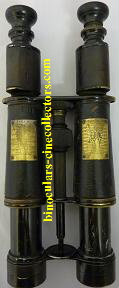 
|
|
|
Huet Proto, Prism 18 x 36; ca 1900 -1910
The binocular was manufactured by Clermont-Huet in Paris.
As above the binocular consists two parts: prisms housing on the binocular’s top and below it the telescopic tubes.
As Dr. Hans Seeger pointed in his new book, the binocular is fitted with 14 optical elements.
The plates are marked; left plate - PROTO; right - PRISM.
The objective is 36 mm diameter.
Production number BE S 606
. |
|
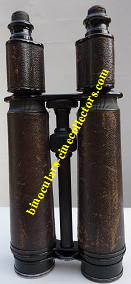 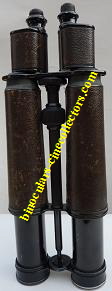
|
|
|
Antique Monocular Brass & Mother of Pearl
The monocular was produced in late Victorian period, around 1890.
The monocular was named Spyglass in Victorian England and in France it was called Lorgnette de Theatre. It is a kind of telescope.
At that period, it was a Gentlemen monocular, which was taken to the Opera, to horse races and to other events for the Gentleman.
They were produced more expensive models, as well; in gold and Mother of Pearl, specially carved and incrusted, and with 2-8 draw action etc.
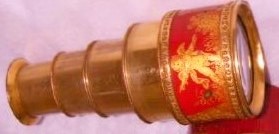
The 8 draw monoculars were produced from brass, silver, silver gilt or gold as a pocket telescope. Often, the base of those telescope were covered with Mother of Pearl, ivory and other elegant materials - such as shagreen (a kind of untanned fish skin with a rough granulated surface):

or sharks skin.
Our monocular has 1 draw tube. It is 80 mm (3.14 in) long when it is extended, and 60 mm (2.36 in) collapsed (Pict 3).
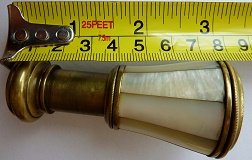
Pict 1; Extended Monocular; in our collection; © Anna Vacani
The diameter of the objective is 26 mm (1.02 in) and ocular is 16 mm (0.62 in).
|
|
 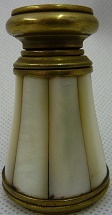
Pict 2,3; Monocular Brass & Mother of Pearl in our collection; © Anna Vacani
 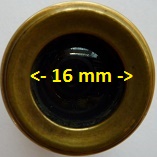
Pict 4,5; Objective & Ocular diameters; © Anna Vacani
|